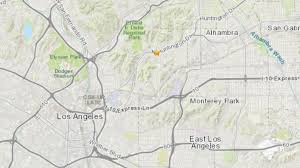Seismic Events Near Los Angeles: Earthquake Details
On Monday morning, the San Gabriel Valley experienced two magnitude-2.8 earthquakes, which originated east of Los Angeles. The initial tremors occurred shortly after 10 a.m., with their epicenters located near South Pasadena and Monterey Park. Residents in surrounding areas, including Alhambra, Pasadena, and Montebello, reported feeling the ground shake. This incident has once again highlighted the region’s ongoing susceptibility to seismic activity, a characteristic that residents have come to know well.
Impact on Local Communities
Despite the noticeable shaking felt by residents, local authorities were quick to report no immediate injuries or major structural damage from the quakes. However, these minor events serve as a crucial reminder of the seismic risks faced by communities in Southern California. While a magnitude-2.8 quake might not typically elicit significant concern, it raises conversations about community preparedness and the reality that larger and potentially more destructive earthquakes could follow.
Preparedness Initiatives
In light of the recent seismic activity, the Los Angeles County Office of Emergency Management took proactive measures by urging residents to reassess their emergency preparedness plans. They emphasized the importance of having sufficient supplies on hand, which includes water, non-perishable food, and essential medical items. Furthermore, the office recommended that residents secure heavy furniture and appliances within their homes, as these actions can help reduce the risk of injury during future earthquakes.
Discussions on Infrastructure Resilience
The recent earthquakes have sparked discussions among local officials regarding the necessity for ongoing investment in infrastructure resilience. With California’s history of seismic activity, there is a growing consensus on the need to retrofit older buildings and enhance early warning systems. Such measures are aimed at reducing the impact of future earthquakes, especially as experts suggest that the probability of significant seismic events continue to rise.
The Role of Education and Awareness
Beyond physical preparedness, there is also an increasing focus on education and public awareness regarding earthquake safety. Local emergency management agencies are exploring avenues to educate residents on the appropriate actions to take before, during, and after an earthquake. Community workshops, informational campaigns, and collaboration with schools and businesses are all parts of a comprehensive strategy to empower citizens to respond effectively to seismic threats.
Long-term Seismic Risks and Predictions
Seismologists warn that while these recent earthquakes were minor, they serve as a reminder of the significant seismic risks inherent to the region. Experts continue to study fault lines and historical data to understand potential future events better. The consensus is clear: stronger and more catastrophic earthquakes are likely on the horizon, necessitating both public awareness and infrastructural preparedness.
Conclusion
The two magnitude-2.8 earthquakes near Los Angeles are a crucial reminder of the seismic realities faced by communities in Southern California. While immediate reports indicate no injuries or damage, the events emphasize the necessity for residents to stay prepared and educated about earthquake safety. Local authorities are actively promoting preparedness initiatives and discussing infrastructure improvements to ensure community resilience in the face of future seismic events. As California continues to grapple with its geological threats, a collaborative approach among residents, officials, and experts will be essential for safety.
FAQs
What should I include in my emergency supply kit for earthquakes?
Your emergency supply kit should include water, non-perishable food, a flashlight, a battery-operated radio, a first-aid kit, any necessary medications, and important documents. It’s also advisable to have a whistle to signal for help and extra batteries.
How can I secure heavy furniture in my home?
To secure heavy furniture, you can use anti-tip straps that attach furniture to the wall, placing heavier items on lower shelves, and ensuring that bookcases and dressers are anchored to the wall securely.
What should I do during an earthquake?
During an earthquake, drop to your hands and knees, cover your head and neck under a sturdy piece of furniture, and hold on until the shaking stops. If you are outdoors, move to an open area away from buildings, trees, and power lines.
Are smaller earthquakes a sign of a larger one to come?
Not necessarily. While foreshocks or swarms of smaller earthquakes can precede larger quakes, they can also occur independently. However, they should always be taken seriously as part of an overall pattern of seismic activity.
Where can I find more information about earthquake preparedness?
For detailed information on earthquake preparedness, visit the websites of local emergency management agencies, the Federal Emergency Management Agency (FEMA), and the United States Geological Survey (USGS). These resources often provide checklists, guidelines, and up-to-date information on seismic activity.

